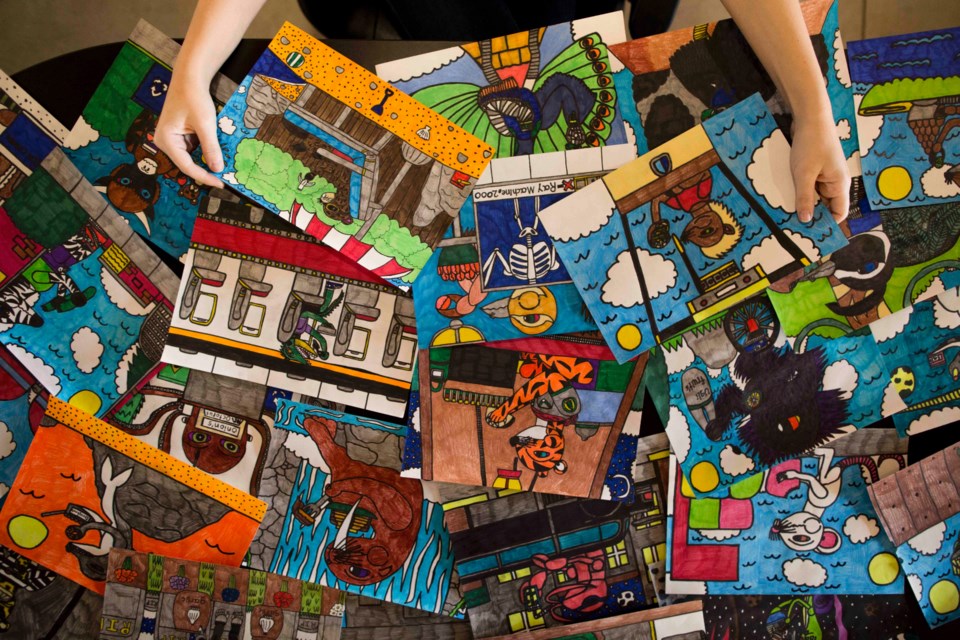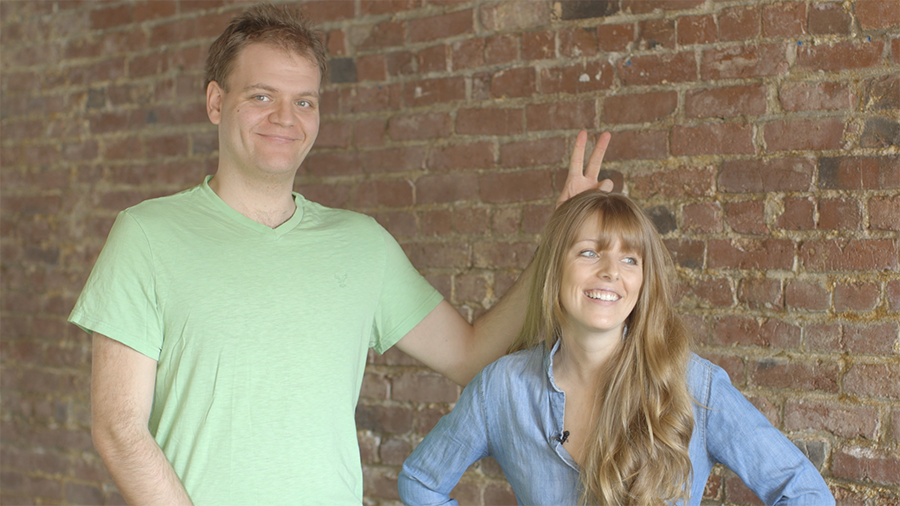When it came time to create her children’s book, Animal Appetites, Andrea Bull faced two challenges: not only was it her first time writing and self-publishing a book, but it was the first time working on such a project with her brother.
Her brother, Robert J. Bull, was diagnosed with autism at age four. In the days before the autism spectrum existed, he was categorized as “medium functioning”. According to Andrea, he can read, do basic math, take care of his hygiene, and get himself to and from work by bus at a level she compares to a 10- or 12-year-old.
Only 18 months older than him, Andrea says she easily connected with Robert when they were kids.
“It aways seemed pretty normal to me,” says Andrea, speaking with Westender by phone. “If he didn’t understand something I would just explain it a different way – because I didn’t have any perspective, I guess,” she adds with a chuckle.

At the beginning of the project, Andrea, now 29, had simply planned to make a book of her brother’s many drawings as a Christmas present for their parents. But when the Vancouver audiologist started to dabble with the words to a book of ABCs and began giving Robert her alliterations to illustrate, clarity, including giving Robert the exact right size of paper to draw on, became the key.
“If you ask him to do something or you’re asking him for help, you have to be really clear. You can’t make any assumptions,” explains Andrea. “Like, if you tell him to water the plants, he’ll go out and water the plants but he’ll water them for eight hours. You have to tell him, ‘Go out and water these plants for this many minutes,’ and if you give him all the parameters then he’s good.”
The results amazed her, and Andrea now hopes, with one in 68 children living with autism or some form of autism spectrum disorder, that holding a copy of her brother’s book will offer families grappling with new diagnoses solace and inspiration.
“I’ve seen his art for years, and I never expected what I got back,” she says. “Which just goes to show you, you give someone the right opportunity and anything is possible. Even someone who believes in him 110 per cent, I never thought that he’d be able to do this.
“It is a good example to other families,” she continues. “Especially families with new diagnoses, where it kind of feels like the world is caving in: there’s lots of things that they can do and be successful at.”
The siblings went on to not only complete the book, but launch a successful Kickstarter, which got the Staff Pick seal of approval and exceeded their funding goals, raising $8,816.
Launching just in time for October’s Autism Awareness Month, the book – a colourful ABC of animals eating their favourite snacks, written by Andrea and illustrated independently by Robert – is meant to raise money for the Canucks Autism Network as well as demonstrate the capabilities and talents of children and adults with autism, with copies of the book available for $10.95 at AnimalAppetitesBook.com.
“Rob and I hope to help others understand that autistic children and adults are capable of incredible things – they may just require a different kind of support to achieve them,” says Andrea passionately. “Even if Robbie doesn’t understand the full scope of our project, he understands that it will help people, he understands that he can do something, and so why not, even it’s a limited understanding of something. They can still very much participate.”
• BC Book Club is giving away a copy of of Animal Appetites; enter to win here!
More with Andrea Bull:
Your project was a Kickstarter staff pick; why did they choose you and how did that help your book campaign?
We have no idea! When I was putting up the campaign I looked at other successful Kickstarters and saw what drew people to them, what inspired confidence, what kind of information to provide for people to feel like it was actually going to happen. And my boyfriend is a videographer, so he put together a really great video, which I think made a lot of difference towards communicating what the project was really about because sometimes words aren’t enough.
Kickstarter says that every morning the staff review all of the videos and projects that have gone up in the last 24 hours, and they go through to see: are the rewards balanced and do they make sense for the prices that they’ve put; are they things that aren’t costing an arm and a leg, because the campaign shouldn’t just go to funding the rewards they should support the project; and how clear is the idea. So they said it was based on an overall strength of the presentation of the project.
We were really excited; and because it was a staff pick it stayed on the "Publishing in Vancouver" page because there weren’t a lot of other projects being published in Vancouver at the time of the Kickstarter. So it stayed on the front page of that specific section for the entire run, which was great.
And you guys raised $8,816, was that enough?
It was! Our initial goal was $6,600 and we had to make “stretch goals” because any time you’re getting more money you have to justify where it’s going and why you need more, so we were pushing to do the activity sheets which we ended up being able to do. So we took all the colour out of the images and made them into colouring pages. We tried to raise $10,000 to make it into a hardcover book, but we didn’t quite get it there, so it’s a soft cover, but the way it turned out is really awesome.
Did you find a publishing partner or were you paying for the entire process yourselves with this money?
We’re paying for the entire process ourselves. I was thinking of going through a traditional publisher, but the research that I did found that it’s very hard to go… He just drew the images to what he wanted – some of them were on 8.5x11 some of them were on A4 [laughs] so if you bring that kind of stuff to a publisher they kind of go, ‘Okay…” Their workflow is different, and I really wanted to profit share the profits with the Canucks Autism Network, and I didn’t know how that worked because I knew nothing about the publishing world – literally nothing – so I figured self publishing was probably the easiest way to go.
Well… not really easy in the end, but easier for me to get the specs that I wanted and profit share the way that we are. We’re still going to send them out to traditional kids publishers now that it’s done, and see if anybody picks it up for further distribution. But it will be available online and hopefully some bookstores this October.
This being a monthly column about BC books, I’m really curious about your book-making process. If you had no experience with this world, why did you want to make a book?
Well… Ha. It started out as a Christmas present idea for my parents, to make an art book of some of Robbie’s art, because he’s drawing all the time and he’s got boxes and boxes of pictures. And then it grew – I really wanted a challenge for myself, I really like learning new things and it seemed complicated but I was curious about how it would work. Then I started writing the alliteration for some of the letters just as a challenge for myself on the side, and then I thought, I wonder what he could do with this. As the images started coming back and friends and family saw what was happening, we got tons of support and encouragement.
What were some of the challenges of actually making your own book?
Well, the publishing industry in general is horribly complicated. I learned very quickly that children’s books are 32 pages. That’s just the standard. I don’t know where the number came from – maybe for offset printing – and so we had to make sure we were fitting a certain page number, and then what are children’s book sizes, what kind of layout do they use.
And then I found it really difficult to find a self publisher who was really accommodating to the idea of print-on-demand (printing books as customers purchase them) because printing the ream of 5,000 books offshore isn’t something that we’d be able to afford, even with a Kickstarter. We’d have to raise like $30,000 or something like that. So I looked up a lot of print on demand and did a lot of research about companies and quality and found BookBaby. They’re been absolutely accommodating. They give you a name and number of a person who tracks your project from start to finish. They have a few limited parameters – book sizes and paper types – but it’s all industry quality and standard. I also found a graphic designer just by googling “children’s book designer Vancouver” and came up with Elisa Gutiérrez and she knew quite a bit about the industry and gave me a lot of support in terms of what was realistic.
Has Robert’s art evolved over the years, or is he still drawing in a similar style as when you were growing up?
It’s changed a little bit, only because we hounded him to refine it a little bit. It’s hard to describe, but he used to draw pictures, and if he drew a circle one way and it wasn’t quite right, he’d draw another circle over top of it. But he wouldn’t erase the original, so his drawings were really messy before, because I guess in his mind he can just block out what’s not supposed to be there, and see the final product. So we got him to start using erasers. And because he was drawing so much with pencils, my mom stared getting him to colour them, because it would slow him down. [laughs]
What would you say is a common misconception about autism?
I think people don’t really see the potential, with a lot of autistic people. You hear about savants or people who are really good with numbers or dates, but people don’t understand the wider implications of that. Robbie, he’s a janitor, and if you show him what to do once, he’ll do it exactly the same way to the exact same quality standard every single time for 30 years. It will never waver.


